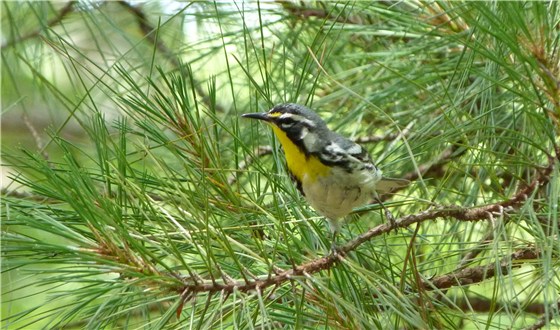The Warbler Guide: a new type of bird book
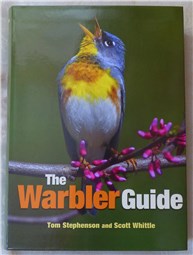
A very loud thud on the door mat announced the arrival.
The Warbler Guide is immediately impressive. It has over 500 pages packed with amazing photographs! The authors, Tom Stephenson and Scott Whittle have done a brilliant job sourcing so many high quality images.
North American warblers have a very special place in the hearts of many UK birders. To see one of these little gems on our side of the pond is a massive thrill. Perhaps the ultimate vagrant for any twitcher and the holy grail for the rarity finder? How these warblers survive an Atlantic crossing is mind-boggling! They are stunning looking birds; even in Autumn, they knock spots off our European warblers.
My first encounter with an American wood warbler was long ago on the Isles of Scilly, a Blackpoll Warbler, and I can still remember the excitement when the news broke of its discovery. A lung-bursting run resulted in views of the rarity feeding in ivy in weak Autumn sunshine. I thought I had died and gone to heaven! A Blackpoll Warbler in my bins, just wonderful. For years I had drooled over field guides that showed these gorgeous birds that very rarely reached the shores of the UK, and now I had seen one.
More of these amazing birds followed with my regular trips to the magical Isles of Scilly: more Blackpolls, which went through a spell of making almost annual appearances, humbug-like Black-and-white Warbler was another bird that we ran fast for, up hill to the Garrison above St Mary's.
Then more colourful a Parula Warbler turned up! This really took American warblers to a new level: a blue, orange and yellow flash hanging upside down in a sycamore tree caused an adrenalin overload!
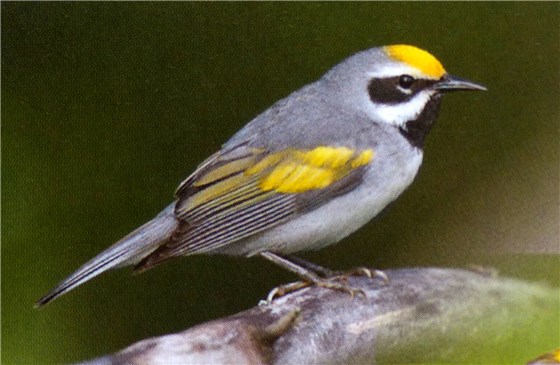
Golden-winged Warbler: just one UK record.
One bird we had not expected was found, bizarrely, in February. The news was bordering on un-believeable: a Golden-winged Warbler had been seen in Kent! All life was put on hold instantly and we were off driving through the night to reach Kent before dawn. First light saw hundreds of birders invading the housing estate where the bird had been seen! Luckily we were in the right place at the right time and had fantastic views of this mega rarity.
These vagrants were wonderful birds and each one is etched on the memory. The places they where they had been seen and the people they were enjoyed with all form the folklore of birding. In my mind these American warblers are the cream of many of my birding memories. But it was a visit to the coast of Texas, in April, that really showed just what American warblers are all about. Autumn (aka fall) birds in the UK are exciting vagrants but here in Texas in Spring they were totally mind-blowing!
If only we had had a book like The Warbler Guide on that first trip to the USA. The warblers of North America are very special birds indeed not only colourful but fascinating and enigmatic and this new book shows them off wonderfully!
All fifty-six species, yes 56, of North America warbler are covered in great detail and lavishly illustrated with what must be the greatest collection of warbler photographs ever published? The book opens with a twelve point guide on "How to use this book". Do read this as this book really does break new ground with the way it looks at bird identification and the presentation of information. One of the new approaches is the inclusion of "quick finder" pages. These show warblers in similar poses all on the same page, admittedly small images, and gives a quick overview to help you identify a bird you have seen. This includes a great plate of the underside view of the warblers. How often have we said, "We need pictures of how we actually see the birds in the field"? This very helpful plate is followed by a diagram comparing the undertail patterns of the birds, just what we need to help nail that uncooperative warbler high in the canopy.
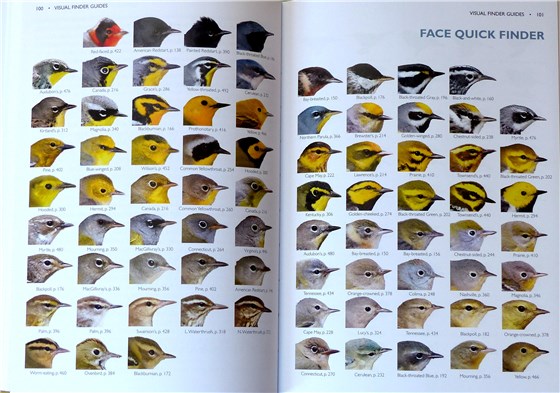
A double page spread of warbler faces!
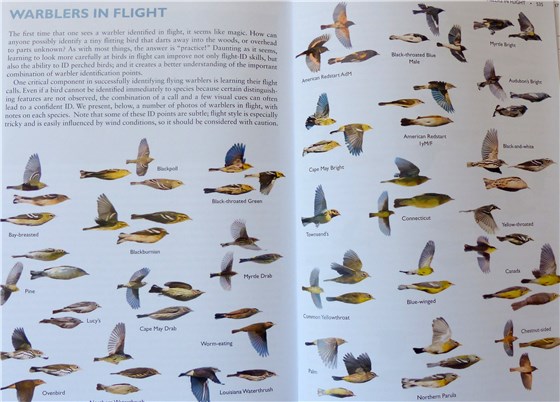
And of warblers in flight, amazing stuff.
But we are getting ahead of ourselves here and have skipped over a whole chunk of the book! Each species has a distribution map and these are clearly explained so that the reader can get the most from the information displayed. These maps include the range of sub-species and show "Time Span" - the period when the species is migrating in Spring and Autumn (fall).
A very clear topographic tour shows all the important features to look for on warblers. The simple colour outline around feather tracts is a brilliant idea and makes seeing those tertials and secondaries so much easier. Why has this not been done before?
Next up is another new idea; "What to notice on a warbler" takes you through contrast and colour, size, shape, habitat, behaviour, face, body, and undertail. All sections are broken down into easy-to-understand sub-sections so you are not overwhelmed by data. The use of many colour photos again brings the text to life and makes each point easy to understand, though make no mistake, there is a lot to take in here!
A thirty-eight page section on songs and calls is the only section of the book not lit up by amazing images of mouthwatering birds. Some people may be tempted to skip past this monochrome section in the rush to get to the colourful stuff, I did! But do go back and take your time to read this section slowly. It will, once you have got your head around sonograms, help enormously with your identification of all birds, not just warblers.
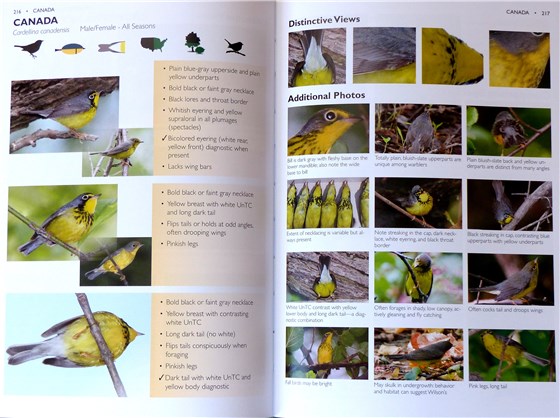
On page 138 we reach the species accounts, the real body of this detailed book.
Each species has a set of icons which, at glance, tell the reader the shape, colour impression given, tail pattern, quick distrbution range, habitat and behaviour. All that information in just six icons - brilliant! Wonderful photos then follow, chosen to highlight the identification features mentioned in the text. Large images are followed by smaller ones entitled "Distinctive Views". These show key areas to concentrate on in order to clinch the ID of each species, whata great idea. More pictures follow showing a variety of poses to lock in the features. Next up are images of similar species making quick comparison easy, so there is no flicking back and forth through the guide to compare birds. Aging and Sexing are featured next and include more photos of female and immature birds so you are ready for any plumage you may encounter. Where the sexes are different the male and females have a complete section for each, so useful as so often females and immatures treated as also rans. A detailed map appears here and then a section on song and calls with more of those sonograms to get to grips with, but it's worth persevering!
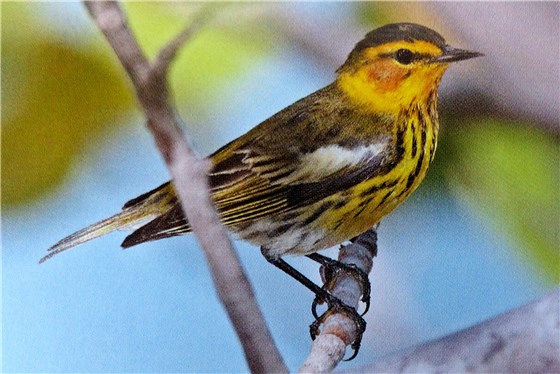
A stunning male Cape May Warbler, who wouldn't want to see one?
Hundreds of pages are packed with information and stunning images to enjoy in many ways. You can flick through, dreaming which species you would like to find on your local patch. You can plan your next birding trip to North America and ensure you will be well prepared for all those colourful warblers. You can learn a lot about bird song and calls. And how about a European version of this book! Anyone up for this challenge? I for one would be head of the queue to buy it.
But wait, we not quite at the end of the book yet! Yes there is still more: a handy section on non-warbler but similar species. This covers a host of birds that could, and have in the past, been mistaken for warblers. Good to see an identification guide that acknowledges that this happens, as so often a book on a particular family of birds misses this useful section out. A short section covers hybrid warblers, a nightmare for an innocent abroad in North America. Another new feature is the quiz section, a picture of a warbler is talked through leading you to the correct identification, again all very useful. A double page spread covers warblers in flight, very tricky for most of us!
So as we hope you now see this really is a book packed with information and really should be on every birder's book shelf. At this time of year, September, warblers are moving and with a Black-and-white Warbler already found on the Shetland Isles more may come across the pond. Now you can be ready for whatever warbler arrives. Those heading out to the Azores this autumn will need to make room in their luggage for this book,which could be invaluable in nailing a first for the Western Palearctic. If you live in North America or are planning a visit then you really should own a copy of this brilliant guide, it will often be of great help.
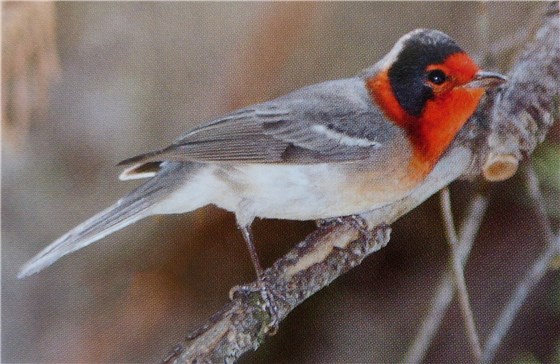
Red-faced Warbler, never likely to make it here, but well worth traveling to see!
The Warbler Guide is highly recommended and the authors are to be congratulated on producing such a marvellous book that will be used by birdwatchers for many years.
The Warbler Guide is published by Princeton University Press
ISBN number 978-0-691-15482-4
You can get your copy of The Warbler Guide from Wildsounds for £17.95 see
http://www.wildsounds.co.uk/
Enjoy a new type of field guide, we think we will see many more like it!
